Opinion & Analysis
3 Reasons you should watch more women’s golf on TV

If you play golf, you probably watch golf on TV, too. For most, that probably means tuning into men’s events, or at least the four major championships.
But I have a question for you: Why do you watch men’s golf?
It’s completely understandable to want to watch the best and most popular golfers in the world. It’s exciting to watch the golfers you know and love, and witness them blasting 300-yard drives. That being said, if you’re looking to improve your own game, I suggest flipping on an LPGA Tour event, at least once in a while. The players are precise, consistent, and dominant in totally different ways — ways that likely look more comparable to your own golf game. Want to know why? Here are three reasons you should pick up the slack when it comes to watching women’s golf.
1) Shotmaking
LPGA Tour courses (based on their average length) require shots similar to the ones played by the average golfer. While impressive, it’s challenging for me to relate to players in the men’s game who hit a 9-iron almost 200 yards. Most of us don’t have that shot in our bag. It’s more beneficial to me, and to most average male golfers, to see how LPGA golfers manage a golf course and the various shots. For instance, most golfers cannot go for the green on par-5 in two from 290 yards, so what yardage are the women laying up to? How are they attacking a 320-yard hole that isn’t drivable for them, or how do they deal with the second shot from 220 yards on a long par-4?
You can learn a lot from LPGA players in how they maneuver around a golf course while hitting the golf ball similar distances that you do.
2) Swing Speeds
With the average swing speed on the PGA Tour being 113 mph with a driver, it’s a pretty tough thing to duplicate – even for the very low-handicapped amateur player. The average swing speed for a 14-handicap male player is around 93 mph, which is almost identical to the average speed of an LPGA Tour player (94 mph). There’s a rhythm and a tempo that comes along with that speed, which the everyday player can identify with. Next time you tune into the LPGA Tour, put a golf club in your hand and mimic their tempo; this may help you smooth out your transition, or learn to slow down altogether!
3) Accuracy
Professional women golfers play the game how most people want to play (or, how most people should try to play). They are unbelievably accurate, rarely hit it out of play and are very consistent. These players will reinforce the lessons amateur golfers receive from their instructors. Every time I turn on coverage, I am amazed by the course management skills of every player. They rarely find themselves in a precarious position. I think every amateur golfer’s game would improve by channeling some of the accuracy of these women. The bomb-and-gouge style of play often seen on the PGA Tour is effective, but only if you have the strength and speed to escape from the rough or other difficult situations that style leads to.
Let’s be clear: This is not to say that the phenomenal talent that you see week-in and week-out on the men’s tour isn’t worth watching – it is. But if you’re a golfer interested in all aspects of the game (and bettering the parts that you struggle with), you should be flipping on women’s golf coverage, as well. If you’ve got a tee time the next day and don’t have time to get or watch a lesson? Watch a few holes of that week’s women’s event. It’s important to absorb information to improve your game. The men may have the daring feats that everyone wants to pull off, but the women have the game that will translate easier to yours. Do yourself, and your game, a favor and check them out.
- LIKE792
- LEGIT108
- WOW17
- LOL9
- IDHT2
- FLOP4
- OB4
- SHANK38
Instruction
The Wedge Guy: The easiest-to-learn golf basic

My golf learning began with this simple fact – if you don’t have a fundamentally sound hold on the golf club, it is practically impossible for your body to execute a fundamentally sound golf swing. I’m still a big believer that the golf swing is much easier to execute if you begin with the proper hold on the club.
As you might imagine, I come into contact with hundreds of golfers of all skill levels. And it is very rare to see a good player with a bad hold on the golf club. There are some exceptions, for sure, but they are very few and very far between, and they typically have beat so many balls with their poor grip that they’ve found a way to work around it.
The reality of biophysics is that the body moves only in certain ways – and the particulars of the way you hold the golf club can totally prevent a sound swing motion that allows the club to release properly through the impact zone. The wonderful thing is that anyone can learn how to put a fundamentally sound hold on the golf club, and you can practice it anywhere your hands are not otherwise engaged, like watching TV or just sitting and relaxing.
Whether you prefer an overlap, interlock or full-finger (not baseball!) grip on the club, the same fundamentals apply. Here are the major grip faults I see most often, in the order of the frequency:
Mis-aligned hands
By this I mean that the palms of the two hands are not parallel to each other. Too many golfers have a weak left hand and strong right, or vice versa. The easiest way to learn how to hold the club with your palms aligned properly is to grip a plain wooden ruler or yardstick. It forces the hands to align properly and shows you how that feels. If you grip and re-grip a yardstick several times, then grip a club, you’ll see that the learning curve is almost immediate.
The position of the grip in the upper/left hand
I also observe many golfers who have the butt of the grip too far into the heel pad of the upper hand (the left hand for right-handed players). It’s amazing how much easier it is to release the club through the ball if even 1/4-1/2″ of the butt is beyond the left heel pad. Try this yourself to see what I mean. Swing the club freely with just your left hand and notice the difference in its release from when you hold it at the end of the grip, versus gripping down even a half inch.
To help you really understand how this works, go to the range and hit shots with your five-iron gripped down a full inch to make the club the same length as your seven-iron. You will probably see an amazing shot shape difference, and likely not see as much distance loss as you would expect.
Too much lower (right) hand on the club
It seems like almost all golfers of 8-10 handicap or higher have the club too far into the palm of the lower hand, because that feels “good” if you are trying to control the path of the clubhead to the ball. But the golf swing is not an effort to hit at the ball – it is a swing of the club. The proper hold on the club has the grip underneath the pad at the base of the fingers. This will likely feel “weak” to you — like you cannot control the club like that. EXACTLY. You should not be trying to control the club with your lower/master hand.
Gripping too tightly
Nearly all golfers hold the club too tightly, which tenses up the forearms and prevents a proper release of the club through impact. In order for the club to move back and through properly, you must feel that the club is controlled by the last three fingers of the upper hand, and the middle two fingers of the lower hand. If you engage your thumbs and forefingers in “holding” the club, the result will almost always be a grip that is too tight. Try this for yourself. Hold the club in your upper hand only, and squeeze firmly with just the last three fingers, with the forefinger and thumb off the club entirely. You have good control, but your forearms are not tense. Then begin to squeeze down with your thumb and forefinger and observe the tensing of the entire forearm. This is the way we are made, so the key to preventing tenseness in the arms is to hold the club very lightly with the “pinchers” — the thumbs and forefingers.
So, those are what I believe are the four fundamentals of a good grip. Anyone can learn them in their home or office very quickly. There is no easier way to improve your ball striking consistency and add distance than giving more attention to the way you hold the golf club.
More from the Wedge Guy
- The Wedge Guy: Golf mastery begins with your wedge game
- The Wedge Guy: Why golf is 20 times harder than brain surgery
- The Wedge Guy: Musings on the golf ball rollback
- LIKE83
- LEGIT13
- WOW4
- LOL1
- IDHT0
- FLOP4
- OB1
- SHANK8
19th Hole
Vincenzi’s 2024 Texas Children’s Houston Open betting preview

As the Florida swing comes to an end, the PGA Tour makes its way to Houston to play the Texas Children’s Houston Open at Memorial Park Golf Course.
This will be the fourth year that Memorial Park Golf Course will serve as the tournament host. The event did not take place in 2023, but the course hosted the event in 2020, 2021 and 2022.
Memorial Park is a par-70 layout measuring 7,432 yards and features Bermudagrass greens. Historically, the main defense for the course has been thick rough along the fairways and tightly mown runoff areas around the greens. Memorial Park has a unique setup that features three Par 5’s and five Par 3’s.
The field will consist of 132 players, with the top 65 and ties making the cut. There are some big names making the trip to Houston, including Scottie Scheffler, Wyndham Clark, Tony Finau, Will Zalatoris and Sahith Theegala.
Past Winners at Memorial Park
- 2022: Tony Finau (-16)
- 2021: Jason Kokrak (-10)
- 2020: Carlos Ortiz (-13)
In this article and going forward, I’ll be using the Rabbit Hole by Betsperts Golf data engine to develop my custom model. If you want to build your own model or check out all of the detailed stats, you can sign up using promo code: MATTVIN for 25% off any subscription package (yearly is best value).
Key Stats For Memorial Park
Let’s take a look at several metrics for Memorial Park to determine which golfers boast top marks in each category over their last 24 rounds:
Strokes Gained: Approach
Memorial Park is a pretty tough golf course. Golfers are penalized for missing greens and face some difficult up and downs to save par. Approach will be key.
Total Strokes Gained: Approach per round in past 24 rounds:
- Tom Hoge (+1.30)
- Scottie Scheffler (+1.26)
- Keith Mitchell (+0.97)
- Tony Finau (+0.92)
- Jake Knapp (+0.84)
Strokes Gained: Off the Tee
Memorial Park is a long golf course with rough that can be penal. Therefore, a combination of distance and accuracy is the best metric.
Total Strokes Gained: Off the Tee per round in past 24 rounds:
- Scottie Scheffler (+0.94)
- Kevin Dougherty (+0.93)
- Cameron Champ (+0.86)
- Rafael Campos (+0.84)
- Si Woo Kim (+0.70)
Strokes Gained Putting: Bermudagrass + Fast
The Bermudagrass greens played fairly fast the past few years in Houston. Jason Kokrak gained 8.7 strokes putting on his way to victory in 2021 and Tony Finau gained in 7.8 in 2022.
Total Strokes Gained Putting (Bermudagrass) per round past 24 rounds (min. 8 rounds):
- Adam Svensson (+1.27)
- Harry Hall (+1.01)
- Martin Trainer (+0.94)
- Taylor Montgomery (+0.88)
- S.H. Kim (+0.86)
Strokes Gained: Around the Green
With firm and undulating putting surfaces, holding the green on approach shots may prove to be a challenge. Memorial Park has many tightly mowed runoff areas, so golfers will have challenging up-and-down’s around the greens. Carlos Ortiz gained 5.7 strokes around the green on the way to victory in 2020.
Total Strokes Gained: Around the Green per round in past 24 rounds:
- Mackenzie Hughes (+0.76)
- S.H. Kim (+0.68)
- Scottie Scheffler (+0.64)
- Jorge Campillo (+0.62)
- Jason Day (+0.60)
Strokes Gained: Long and Difficult
Memorial Park is a long and difficult golf course. This statistic will incorporate players who’ve had success on these types of tracks in the past.
Total Strokes Gained: Long and Difficult in past 24 rounds:
- Scottie Scheffler (+2.45)
- Ben Griffin (+1.75)
- Will Zalatoris (+1.73)
- Ben Taylor (+1.53)
- Tony Finau (+1.42)
Course History
Here are the players who have performed the most consistently at Memorial Park.
Strokes Gained Total at Memorial Park past 12 rounds:
- Tyson Alexander (+3.65)
- Ben Taylor (+3.40)
- Tony Finau (+2.37)
- Joel Dahmen (+2.25)
- Patton Kizzire (+2.16)
Statistical Model
Below, I’ve reported overall model rankings using a combination of the five key statistical categories previously discussed.
These rankings are comprised of SG: App (24%) SG: OTT (24%); SG: Putting Bermudagrass/Fast (13%); SG: Long and Difficult (13%); SG: ARG (13%) and Course History (13%)
- Scottie Scheffler
- Wyndham Clark
- Tony Finau
- Joel Dahmen
- Stephan Jaeger
- Aaron Rai
- Sahith Theegala
- Keith Mitchell
- Jhonnatan Vegas
- Jason Day
- Kurt Kitayama
- Alex Noren
- Will Zalatoris
- Si Woo Kim
- Adam Long
2024 Texas Children’s Houston Open Picks
Will Zalatoris +2000 (Caesars)
Scottie Scheffler will undoubtedly be difficult to beat this week, so I’m starting my card with someone who I believe has the talent to beat him if he doesn’t have his best stuff.
Will Zalatoris missed the cut at the PLAYERS, but still managed to gain strokes on approach while doing so. In an unpredictable event with extreme variance, I don’t believe it would be wise to discount Zalatoris based on that performance. Prior to The PLAYERS, the 27-year-old finished T13, T2 and T4 in his previous three starts.
Zalatoris plays his best golf on long and difficult golf courses. In his past 24 rounds, he ranks 3rd in the category, but the eye test also tells a similar story. He’s contended at major championships and elevated events in the best of fields with tough scoring conditions. The Texas resident should be a perfect fit at Memorial Park Golf Club.
Alex Noren +4500 (FanDuel)
Alex Noren has been quietly playing some of his best golf of the last half decade this season. The 41-year-old is coming off back-to-back top-20 finishes in Florida including a T9 at The PLAYERS in his most recent start.
In his past 24 rounds, Noren ranks 21st in the field in Strokes Gained: Off the Tee, 30th in Strokes Gained: Around the Green, 25th in Strokes Gained: Total on long and difficult courses and 21st in Strokes Gained: Putting on fast Bermudagrass greens.
In addition to his strong recent play, the Swede also has played well at Memorial Park. In 2022, Noren finished T4 at the event, gaining 2.2 strokes off the tee and 7.0 strokes on approach for the week. In his two starts at the course, he’s gained an average of .6 strokes per round on the field, indicating he is comfortable on these greens.
Noren has been due for a win for what feels like an eternity, but Memorial Park may be the course that suits him well enough for him to finally get his elusive first PGA Tour victory.
Mackenzie Hughes +8000 (FanDuel)
Mackenzie Hughes found himself deep into contention at last week’s Valspar Championship before faltering late and finishing in a tie for 3rd place. While he would have loved to win the event, it’s hard to see the performance as anything other than an overwhelming positive sign for the Canadian.
Hughes has played great golf at Memorial Park in the past. He finished T7 in 2020, T29 in 2021 and T16 in 2022. The course fit seems to be quite strong for Hughes. He’s added distance off the tee in the past year or and ranks 8th in the field for apex height, which will be a key factor when hitting into Memorial Park’s elevated greens with steep run-off areas.
In his past 24 rounds, Hughes is the best player in the field in Strokes Gained: Around the Greens. The ability to scramble at this course will be extremely important. I believe Hughes can build off of his strong finish last week and contend once again to cement himself as a President’s Cup consideration.
Akshay Bhatia +8000 (FanDuel)
Akshay Bhatia played well last week at the Valspar and seemed to be in total control of his golf ball. He finished in a tie for 17th and shot an impressive -3 on a difficult Sunday. After struggling Thursday, Akshay shot 68-70-68 in his next three rounds.
Thus far, Bhatia has played better at easier courses, but his success at Copperhead may be due to his game maturing. The 22-year-old has enormous potential and the raw talent to be one of the best players in the world when he figures it all out.
Bhatia is a high upside play with superstar qualities and may just take the leap forward to the next stage of his career in the coming months.
Cameron Champ +12000 (FanDuel)
Cameron Champ is a player I often target in the outright betting market due to his “boom-or-bust” nature. It’s hard to think of a player in recent history with three PGA Tour wins who’s been as inconsistent as Champ has over the course of his career.
Despite the erratic play, Cam Champ simply knows how to win. He’s won in 2018, 2019 and 2021, so I feel he’s due for a win at some point this season. The former Texas A&M product should be comfortable in Texas and last week he showed us that his game is in a pretty decent spot.
Over his past 24 rounds, Champ ranks 3rd in Strokes Gained: Off the Tee and 30th in Strokes Gained: Total on long and difficult courses. Given his ability to spike at any given time, Memorial Park is a good golf course to target Champ on at triple digit odds.
Robert MacIntyre +12000 (FanDuel)
The challenge this week is finding players who can possibly beat Scottie Scheffler while also not dumping an enormous amount of money into an event that has a player at the top that looks extremely dangerous. Enter McIntyre, who’s another boom-or-bust type player who has the ceiling to compete with anyone when his game is clicking on all cylinders.
In his past 24 rounds, MacIntyre ranks 16th in the field in Strokes Gained: Off the Tee, 17th in Strokes Gained: Around the Green and 10th in Strokes Gained: Total on long and difficult courses.
MacIntyre’s PGA Tour season has gotten off to a slow start, but he finished T6 in Mexico, which is a course where players will hit driver on the majority of their tee shots, which is what we will see at Memorial Park. Texas can also get quite windy, which should suit MacIntyre. Last July, the Scot went toe to toe with Rory McIlroy at the Scottish Open before a narrow defeat. It would take a similar heroic effort to compete with Scheffler this year in Houston.
Ryan Moore +15000 (FanDuel)
Ryan Moore’s iron play has been absolutely unconscious over his past few starts. At The PLAYERS Championship in a loaded field, he gained 6.1 strokes on approach and last week at Copperhead, he gained 9.0 strokes on approach.
It’s been a rough handful of years on Tour for the 41-year-old, but he is still a five-time winner on the PGA Tour who’s young enough for a career resurgence. Moore has chronic deterioration in a costovertebral joint that connects the rib to the spine, but has been getting more consistent of late, which is hopefully a sign that he is getting healthy.
Veterans have been contending in 2024 and I believe taking a flier on a proven Tour play who’s shown signs of life is a wise move at Memorial Park.
- LIKE15
- LEGIT1
- WOW1
- LOL0
- IDHT0
- FLOP0
- OB0
- SHANK2
Opinion & Analysis
Ryan: Why the race to get better at golf might be doing more harm than good
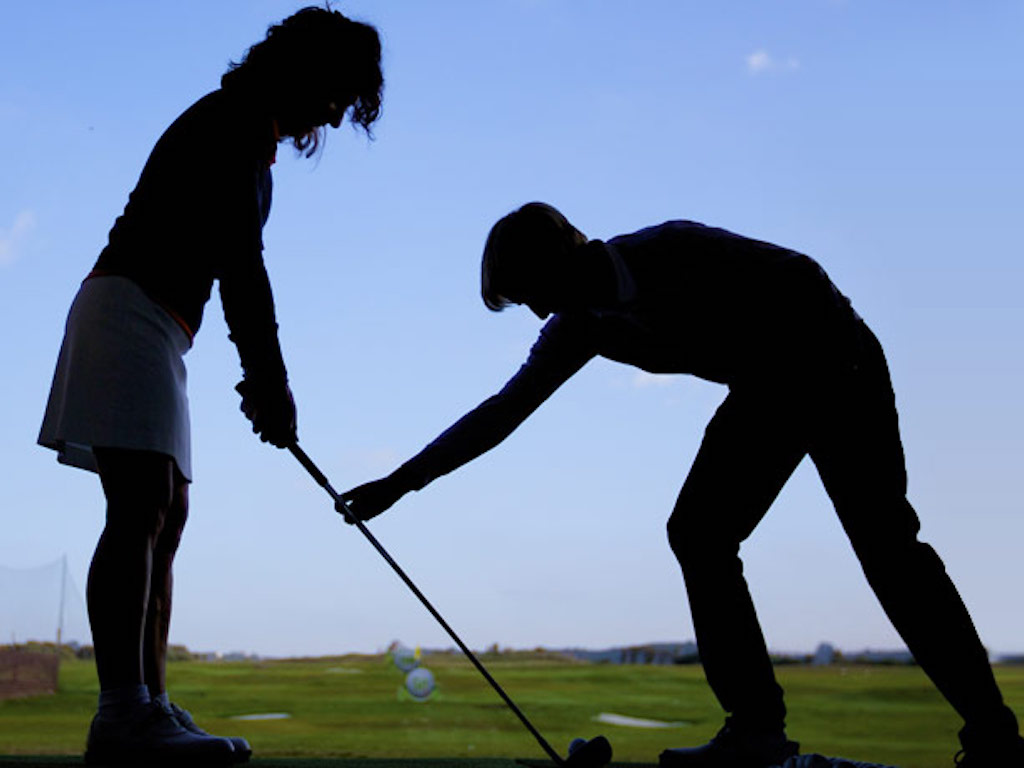
B.F. Skinner was one of the most important psychologists of the 20th century, developing the foundation of the development of reinforcement, and in doing so, creating the concept of behaviorism. In simple terms, this means that we are conditioned by our habits. In practical terms, it explains the divide between the few and far between elite instructors and college coaches.
To understand the application, let’s quickly review one of B.F. Skinner’s most important experiments; superstitions in the formation of behavior by pigeons. In this experiment, food was dispensed to pigeons at random intervals. Soon, according to Skinner, the pigeons began to associate whatever action they were doing at the time of the food being dispensed. According to Skinner, this conditioned that response and soon, they simply haphazardly repeated the action, failing to distinguish between cause and correlation (and in the meantime, looking really funny!).
Now, this is simply the best way to describe the actions of most every women’s college golf coach and too many instructors in America. They see something work, get positive feedback and then become conditioned to give the feedback, more and more, regardless of if it works (this is also why tips from your buddies never work!).
Go to a college event, particularly a women’s one, and you will see coaches running all over the place. Like the pigeons in the experiment, they have been conditioned into a codependent relationship with their players in which they believe their words and actions, can transform a round of golf. It is simply hilarious while being equally perturbing
In junior golf, it’s everywhere. Junior golf academies make a living selling parents that a hysterical coach and over-coaching are essential ingredients in your child’s success.
Let’s be clear, no one of any intellect has any real interest in golf — because it’s not that interesting. The people left, including most coaches and instructors, carve out a small fiefdom, usually on the corner of the range, where they use the illusion of competency to pray on people. In simple terms, they baffle people with the bullshit of pseudo-science that they can make you better, after just one more lesson.
The reality is that life is an impromptu game. The world of golf, business, and school have a message that the goal is being right. This, of course, is bad advice, being right in your own mind is easy, trying to push your ideas on others is hard. As a result, it is not surprising that the divorce rate among golf professionals and their instructors is 100 percent. The transfer rate among college players continues to soar, and too many courses have a guy peddling nefarious science to good people. In fact, we do at my course!
The question is, what impact does all this have on college-age and younger kids? At this point, we honestly don’t know. However, I am going to go out on a limb and say it isn’t good.
Soren Kierkegaard once quipped “I saw it for what it is, and I laughed.” The actions of most coaches and instructors in America are laughable. The problem is that I am not laughing because they are doing damage to kids, as well as driving good people away from this game.
The fact is that golfers don’t need more tips, secrets, or lessons. They need to be presented with a better understanding of the key elements of golf. With this understanding, they can then start to frame which information makes sense and what doesn’t. This will emancipate them and allow them to take charge of their own development.
- LIKE14
- LEGIT4
- WOW1
- LOL2
- IDHT0
- FLOP1
- OB0
- SHANK11
-
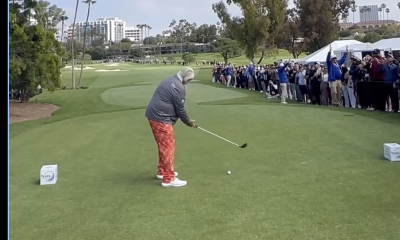
 19th Hole2 weeks ago
19th Hole2 weeks agoJohn Daly stuns fans into silence with brutal opening tee shot on PGA Tour Champions
-

 19th Hole4 days ago
19th Hole4 days agoThings got heated at the Houston Open between Tony Finau and Alejandro Tosti. Here’s why
-

 19th Hole1 day ago
19th Hole1 day agoReport: Tiger Woods has ‘eliminated sex’ in preparation for the 2024 Masters
-

 19th Hole2 weeks ago
19th Hole2 weeks ago2-time major champ announces shock retirement from the sport at age of 33
-

 19th Hole2 weeks ago
19th Hole2 weeks agoEdoardo Molinari reveals the latest PGA Tour golfer to turn down ‘good offer’ from LIV Golf
-

 19th Hole2 weeks ago
19th Hole2 weeks agoCharlie Woods finds it tough going on American Junior Golf Association debut
-

 19th Hole3 weeks ago
19th Hole3 weeks agoScottie Scheffler had an interesting response when asked how he ‘quiets the noise’ following Players victory
-

 19th Hole2 weeks ago
19th Hole2 weeks agoJon Rahm dealt fresh blow to hopes of qualifying for 2025 Ryder Cup



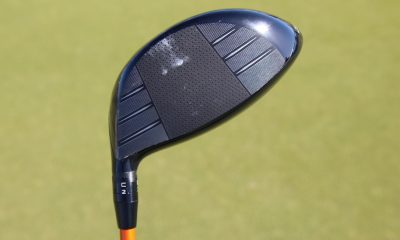







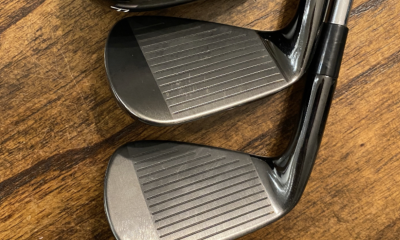

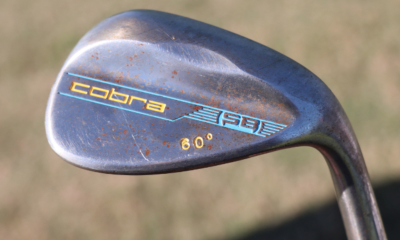













Randy Wall
Jan 29, 2018 at 4:33 pm
I enjoy watching the women play as much as the men. I think they play courses smarter, and have helped me to have good golf IQ.
Tim
Nov 12, 2022 at 11:07 am
The coverage is SO much better!!!!!
Stephen Finley
Jan 9, 2018 at 12:27 am
Male tour players don’t actually hit the ball “almost 200 yards with a 9-iron.” Nowhere near it under normal conditions. Check USGA numbers for average 5-iron length on tour.
Aside from that, there are more reasons than “they’re a scaled-down version of the men’s tour, and the scaling down allows lower-quality players to relate to them and model their games after them.” In fact, I’d say that’s not even true. Anywhere near the top of the women’s game you’re going to see women hitting it 260-270 and up, often 300 or more when conditions are right. It’s unbelievable how far they hit it now, often within a club or club and a half of the guys. And the skill level is just way, _way_ ahead of where it was when I was a kid. It used to be that on the rare LPGA event you saw televised, you might see a couple of shots close to the pin all day. Maybe four or five. Today, it’s not unusual at all to see a three-player group with three shots by the hole, or two out of three. You’ll see more shots tight in half an hour now than you used to see in an entire round of coverage 20 or 30 years ago, more in one tournament than you used to see all year.
As for having 290 to the green on a par-5, I’ve actually seen more than a couple of women pull _that_ off. Might take slightly favorable conditions, but the days of making a living on the LPGA tour driving it 240 and hitting 210-yard 3-woods, trying to keep it around par with a tidy short game, etc., are way over.
I’m not disparaging the women in previous generations — there have always been great players out there — but the strength and speed now, and the level of play, is just incredible. The PGA Tour is always talking about how it’s the “greatest generation ever” (not even close) and how “these guys are good” (they are, but not as insanely perfect as they’re marketed to be), but it’s the _women_ who have made the biggest strides.
JD
Jan 7, 2018 at 10:15 pm
If you can tell the difference between a 350 yard drive and 250 through your t.v., you’re probably in the wrong line of work. Women’s golf looks exactly the same on t.v. and I definitely enjoy watching it so long as the coverage is good.
CrashTestDummy
Jan 5, 2018 at 9:03 pm
The women on the LPGA are so good. I think a lot of people don’t realize how good they are. They are shooting in the 60s regularly at pretty tough tracks.
Try shooting under par at any of your tough local tracks with total yardage of 6000-6700 yards. Not many can say that they can do that.
Bruce Ferguson
Jan 4, 2018 at 11:08 am
I have to wonder how LPGA events are covered in the Asian television markets, because in recent years, there has been such a dominance of Asian tour players. I know at least on KBS (the Korean television channel I occasionally watched through a former satellite provider), they made a big deal of LPGA golf tournament results in their sports segments. There seems to be keen public interest in women’s golf.
I hope that The Golf Channel and network television would commit to providing more LPGA content to expose the game to more American women, and thereby increase overall viewership. There are enough empty voids in Golf Channels line-up as it is. Instead of running Tin Cup and Bagger Vance re-runs hundreds of times, why not run women’s golf features, like exclusive interviews, or a show featuring a female “Feherty” (Christina Kim comes to mind)?
BigSculpin
Jan 3, 2018 at 12:53 pm
I would love to watch more LPGA golf but I would have to get the GOLF Channel to do so.
Stephen Finley
Jan 9, 2018 at 12:33 am
Yeah, that’s a shame. They deserve a wider audience, with the level of play today.
Mike
Jan 23, 2018 at 8:14 pm
I have the golf channel & would love to watch more women’s golf. They really don’t show much.
Nick Nack
Dec 30, 2017 at 6:46 pm
The 4th reason:
Women’s golf needs more viewers because no one is interested.
Kirk Dunn
Dec 27, 2017 at 11:34 pm
Way way ahead of you….been doing this fir qyite awhile….they play same ydg courses as most of us do too
steve2
Dec 30, 2017 at 4:50 pm
…. and I can think of another additional 3 reasons to watch more women’s golf on TV.
Mike Eovino
Dec 20, 2017 at 9:26 pm
Liz – You nailed it. As the father of two female junior golfers (and big Lexi Thompson fans), we watch plenty of LPGA golf. They’re a lot better than I am from the tees I play from.
Klaus
Dec 25, 2017 at 1:41 am
…. and you won’t see a LPGA player pregnant 6 months and trying to swing a golf club…. but I see plenty of men with pot bellies pregnant with fat trying to play golf. It’s hideous and pathetic.
peter
Dec 25, 2017 at 1:42 pm
…. ouch!
Stephen Finley
Jan 9, 2018 at 12:32 am
Where are you seeing “plenty of men with pot bellies” playing professional golf at approximately the same ages as the women?
Luke keefner
Dec 20, 2017 at 5:15 pm
I like watching LPGA events but our tv coverage sucks in the USA. To many commercials, too many talking heads to many “special stories” to plow through. It’s as if the networks think golf isn’t exciting enough so they have to pump it up somehow. Like baseball. I prefer watching the European tour, I can’t pronounce many of the names, but the coverage is all about the golf, and you can tell the announcers love and play the game. And I don’t have to hear about what college the players went to and how HUGE of a fan they are of there college football teams. Over and over and over. I don’t care!
Luke keefner
Dec 20, 2017 at 5:17 pm
Correction “ their college football teams”. Sorry
peter
Dec 25, 2017 at 1:45 pm
I mute my tv when watching golf, tennis, basketball, soccer, and football. It’s amazing how much better it is without the sound of screaming fans and nonsensical commentary. I can see what is happening without distractions…. and when the commercial comes on I stand up and stretch for flexibility.
Bert
Dec 26, 2017 at 6:14 pm
Judy Rankin and er talking points are a huge distraction in addition to the excessive babbling by others.
Larry Schmidt
Dec 20, 2017 at 3:08 pm
I would love to watch the ladies play this great game but when 95% of all womens golf is only on the golf channel and only the majors on national TV it’s kind of hard to watch. If you want to grow the game then get the game on national television.
Joro
Dec 20, 2017 at 2:12 pm
My ex Daughter in Law caddied for years on the tour for Faldo, Stenson, and others and when asked she caddied for Michelle Wie in a few events. After caddying for Wie she said that men should be watching the women more because it is more realistic to most men in distance, management, and swings. She said the men are too unrealistic to be watching the big hits and long irons and play the game they can’t.
Great article.
Peter Douglas
Dec 21, 2017 at 7:36 am
Her name wouldn’t happen to be Fannie would it?
Razor
Dec 20, 2017 at 12:53 pm
Great article and rings true. I’m sure the younger golfers think this article is totally wrong. They just love smashing the ball. I’m in my 50’s and out drive most of the 25-35 year olds in the club. I’ve always said watch the LPGA they are great players and like your article states. More close to an average golfers swing speed and distance. Played in a KPMG Major Pro Am and ALL the girls were super friendly and totally respected the amateur golfer. One even gave me her range spot! Yes. They are easy on the eyes. But they have game and can totally kick our butts. They are good. Please watch and learn how to shoot lower scores.
peter
Dec 25, 2017 at 1:47 pm
What do you “watch” when looking at LPGA players? Be specific.
bonifacj
Dec 20, 2017 at 12:46 pm
Don’t watch a lot of golf, but love watching LPGA pros swing. In large measure, swing tempos just gorgeous. Similar to watching Els swing.
stevek
Dec 20, 2017 at 1:49 pm
I occasionally like to watch LPGA players to study how they develop their kinetic energy chain from the ground up to their shoulder torque rotation.
Their swings are very smooth and slower than the men’s swings but it’s easier to see their legs, hips and shoulder rotation mechanics… because the women wear shorts and skirts that expose their leg and hip action.
Most don’t wear baggy pants like the men so it’s easier to see their kinetic chain developing. The ladies come in different shapes and sizes so it’s interesting to see how they manage their swing mechanics.
Skip
Dec 20, 2017 at 12:34 pm
I watch the LPGA, but my 170mph driver ball speed doesn’t really translate well to their games. Still, can really appreciate the level of skill.
DougE
Jan 27, 2018 at 8:53 am
Not sure I understand. What about the part of the game where you have to get the ball in the hole? All the swing speed in the world doesn’t do that. This game is about accuracy so much more than it is about distance, at least in my opinion. Sure distances helps, but it is not the be all end all. I’m guessing you don’t hit 100% of your fairways and greens with all that distance and speed, so how can you not relate to playing like the women do around the greens, and on approach shots for that matter. I don’t get your logic. No disrespect meant.
Taylor
Dec 20, 2017 at 12:27 pm
Women golfers are outstanding players. But they play like robots, there’s no excitement or fist pumps or any emotion.
Dave Freeman
Dec 20, 2017 at 12:07 pm
I agree Liz. When watching women’s golf, I have always been impressed with how good their swings are. They seem to move the way instructional videos teach you to move.
Chris
Dec 20, 2017 at 11:59 am
Are you kidding?? Who watches women’s golf for the golf??
Jack Nash
Dec 20, 2017 at 11:49 am
I watch to count how many caddies line up a supposed Pro. I also enjoy using my sun dial to time the decision making process before an actual shot is hit. There’s Maybe 15 females worth watching on the LPGA that have a game. Other than that it’s just a fashion show.
frank cichon
Dec 20, 2017 at 11:47 am
I try to watch the LPGA. It is TOO SLOW! The odd time when the camera picks them up running from a tee box…it makes me laugh. Why not enforce the rules and save 30-45 minutes per round. Regarding the article…..I do not recall seeing ( in this century) any LPGA player hitting a 200 yard second shot to any par 4 (is possible if she mishit her drive) Again life is too short to spend watching the LPGA. Hope Santa brings me a new PVR as I wore mine out watching golf on TV
Bert
Dec 26, 2017 at 6:18 pm
Very slow play!
Big Wally
Dec 20, 2017 at 11:45 am
The women do not hit it closer and their short games are not nearly as good as the men and their putting is not as good.
I tune in but it is like watching paint dry. The are slow and humorless.
Marc
Dec 20, 2017 at 11:42 am
Liz:
I volunteer at an LPGA event every year. My assignment is the range. The range is like getting a backstage pass to rock concert. I see everything. Even though there are women on the LPGA tour who are very long, there is also many players who hit drives less than 250 yards. The difference is their wedge play. It’s uncanny how good they are from 125 yards and in. And the reason they are so good is that they PRACTICE! They practice for hours and hit hundreds of balls. And they are extremely nice to the fans.
Brenden Grant
Dec 20, 2017 at 11:40 am
Hey all: Great article Liz spot on. I’ve been saying for years That GolfWRX should do more LPGA witb and not just from tournament winners since their bag setups just like the way they play a course is more like how most amateurs play. Thanks…????????????????
fran
Dec 20, 2017 at 11:38 am
Great article ! I would watch the LPGA more if they showed the analytics and visual track and trace data that is shown for the PGA players. It`s a little boring listening to the announcers when the visual data is so much more compelling and informative.
Gregory M Haney
Dec 20, 2017 at 11:38 am
I am an avid fan of the LPGA and have been to many of their tournaments both overseas and in the USA. Having said that I have numerous complaints. First the TV coverage is less than ideal ( I am being kind here!) as are a few of the announcers. I would like to watch some golf with a few commercials in between instead of Watching so many commercials with a little golf in between!! Here is what I often see; three putts, one swing, go to commercial. Two putts two swings and go to commercial. A number of the tournaments are so bad with this that I turn it off. And most of the coverage is just about putting. With certain announcers, I hit the mute every time they speak. I won’t go into names but some of the announcers should have been gone a long, long time ago. Kudos to Kay Cockerill and Karen Stupples and a few others.
I have measured several tournaments. Most all of the time the distances are not what their score card is showing, i.e they are shorter on many holes.
In many of the tournaments I have been to, there is often a long gap between the next group, in other words you can sit on a hole and there is no one in sight for some time.
Yes, the PGA is guilty of many of the same things. I was just watching a rerun of the HSBC Champions from China this past October. In the 4th round, it took 2:45 minutes to play 9 holes!!! And that is with a two some or three some. No lost balls, no lengthy rulings, some wind. Pro golfers who smoke it long and very straight for the most part. 2:45 for 9 holes is insane!! I know the PGA issued its’ first penalty this past season since when was it, 1999!!!!!
I know the coverage of the LPGA does not have as many cameras as for the PGA, but I would like to see more of the other golfers as well instead of watching the leaders do 18″ tap ins!!!!!!
So, my summary is that if you want better exposure and more people to watch, IMPROVE THE TV COVERAGE (and announcers). Many other male watchers that I speak to about this absolutely agree with me. I met Mike Whan several years ago, twice at tournaments in Asia and would sure like to share my thoughts with him :-).
Gord
Dec 20, 2017 at 11:37 am
I tell my friends all time – if you want to improve, watch the LPGA. Watch them in slow motion to see how a 100lb woman can hit the ball 260yds – straight. Most men that I play with can’t do that – me included!
Rob
Dec 20, 2017 at 11:19 am
Liz, this article is spot on. Well done!!
Alphonso Dubachette
Dec 20, 2017 at 11:09 am
Great article Liz! I couldn’t agree more that as amateurs we all should watch the LPGA and how they use course management. My wife has asked me why I watch the women play, and I’ve given her the same answer. Realistically they play similar to us so I like to see what yardages they’re playing and clubs they use. Of course I watch the PGA, but if I could hit my 7-iron 200yds+ I wouldn’t be a 12.5 handicap. This was probably one the best and most relevant articles I’ve read in a long time.
CB
Dec 20, 2017 at 10:28 am
This article is absolutely true. Sure I watch the PGA, who doesnt. But the LPGA (and champions IMO) are better to watch if you are trying to learn and take something away. The precision is amazing.
Nice writeup.
Rene
Dec 20, 2017 at 9:15 am
FInally! I can convince my wife that I watch the LPGA because of their game, not their long legs and short skirts! 😀
BB
Dec 20, 2017 at 8:00 am
Awesome write up. Best one to me.
Peter Douglas
Dec 20, 2017 at 4:26 am
I think they dumb it down to much. Watch the clubs they hit most of the time!
LPGA stands for (Lob Wedge, Pitching Wedge, Gap Wedge….all day)!
Some very good players but pace of play is tedious.
Jack Gallagher
Dec 20, 2017 at 12:26 pm
Good point Peter Douglas, if you mean the tournament organizers being the ones who dumb it down. Regardless of gender, they shouldn’t set up any course with par fours that are reachable with a driver and a wedge (of any variety) with the exception of the drive-able par four holes.
Skip
Dec 20, 2017 at 12:31 pm
LPGA, lol good one.
TA
Dec 20, 2017 at 3:39 am
T, A, & L, right?
t
Dec 20, 2017 at 1:50 am
reason #1 need a nap
Reason #2 need a second nap
Reason #3 need a third nap
The dude
Dec 19, 2017 at 9:41 pm
Good article….something that is known, but worth reinforcing
Davemac
Dec 19, 2017 at 8:45 pm
Slow play is the bane of professional golf, the game is almost unwatchable. Unfortunately the ladies are ever SLOWER than the men!
The sooner they ban caddies from lining a player up along with the huge green reading books the better.
Talented yes, more relevant yes, watchable no.
Bruce Ferguson
Dec 19, 2017 at 7:50 pm
Agree on all three points. I wish that more LPGA events were broadcast . . . not only because I can relate more to their swing speed and distance, but to expose golf to more women. I think women who know very little about the game assume it’s “a man’s game”.
Scott
Dec 19, 2017 at 6:59 pm
Totally agree and I’ve said your comments for years. LPGA players hit distance more in line with me. They’re shot making is amazing. Don’t get me wrong, watching the men on PGA hit a 350 yd is impressive but I’ll never do that. I walked the course one day during us open at trump and was amazed the distance and shot making I was seeing. Lexi crushed a drive I thought the cover came off the ball. Tremendous article.
james
Dec 19, 2017 at 6:19 pm
You refer a lot to you…..Who is you, as this article is being read by many different people.
The dude
Dec 19, 2017 at 9:38 pm
The average golfer you dolt!…..
David Alan Cheever
Dec 19, 2017 at 5:40 pm
I agree completely. I can relate so much more to how the ladies hit it. I went to an LPGA event once and was amazed how 80% of them landed their tee shots in an area the size of a blanket. well, almost, but damn.
Watching the men is dull, frankly. Same swing on all of them. 9 million yard drives. yawn..
SK
Dec 19, 2017 at 5:38 pm
I love to watch the ladies swing, particularly if they are wearing shorts or skirts and I can see their bare legs and their hip action going into their shoulder rotation.
I’m not being sexist, I’m just saying that the male golfers are fully clothed and it’s difficult to analyze their leg and hip action under their pant legs.
The golfswing kinetic energy chain starts at the feet and legs, and then into hip and shoulder rotation. This is where most of the ‘power’ is generated from the mass momentum of large body parts.
Lady pros come in many sizes and shapes and their ability to swing a golf club is openly revealed if you can see the body unencumbered by baggy clothing. It’s good viewing if you know what to look for in the golfswing kinetic energy chain.
Jonathan
Dec 19, 2017 at 4:40 pm
I agree with all your points. If given the choice between LPGA and Champions Tour I always watch LPGA. Competition is typically very tight on LPGA, which makes it enjoyable to watch.
MRC
Dec 19, 2017 at 4:15 pm
Well said Liz. I watch LPGA events all the time. Rhythm and tempo is something I struggle with…..No better way to improve than to watch the LPGA.
Rob
Dec 19, 2017 at 4:03 pm
Watching a few holes however, will take you about 3 hours as the pace of play is an embarrassment… and caddies lining players up! What is that. Otherwise, lpga/let tours are brilliant.
Jim
Dec 19, 2017 at 3:48 pm
This is a fantastic article and i couldn’t agree more about the women’s game. They have similar carry distances to men but are just phenomenal in every aspect of the game. I really enjoy watching them but my only gripe is that the LPGA plays course way too short. They “say” they play at 6500 yards but never do and they always play them super firm and fast and seem to be hitting wedges all day outside of the par three. These women are talented, let them hit some longer clubs!
ChristopherKee
Dec 19, 2017 at 5:06 pm
I agree here. Ariya Jutanugarn plays an iron off the tee 99% of the time. She doesn’t even have a driver in her bag. I know golf shouldn’t be about “distance” but it shouldn’t be about just wedges either.
Andrew Pavlov
Dec 20, 2017 at 10:12 am
Golf is about getting the ball in the hole in the least number of strokes possible period and nothing else. Whatever clubs someone uses to do so are the right ones.
ChristopherKee
Dec 20, 2017 at 11:51 am
You’re correct. And I don’t care if they use a putter from tee to green to be honest, it would probably be entertaining to watch. My observation of the club used off the tee by Ariya was to the challenge, or lack of, some of the girls have off the tee on the course.
I feel a lot of them are way better than the tour is showcasing. I would prefer the easier courses to be a bit longer to challenge some of the more capable players. It’s the same thing I like to see on the men’s tour.
These are the best of the best women in golf, I would just like to see them really challenged.
Jack Gallagher
Dec 20, 2017 at 12:34 pm
If that were true, Andrew Pavlov, then there is every justification to play courses that are only 5,500 yards in length for the men, and 4,500 yards in length for the women. It would have an audience of one – Andrew Pavlov.
MacAllan
Dec 19, 2017 at 3:36 pm
I’m a Swe golfer with hcp 5 and I have said this to my golf friends a long time ago, we have more to learn from LPGA than the PGA Tour.